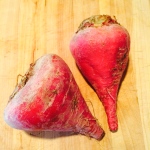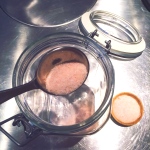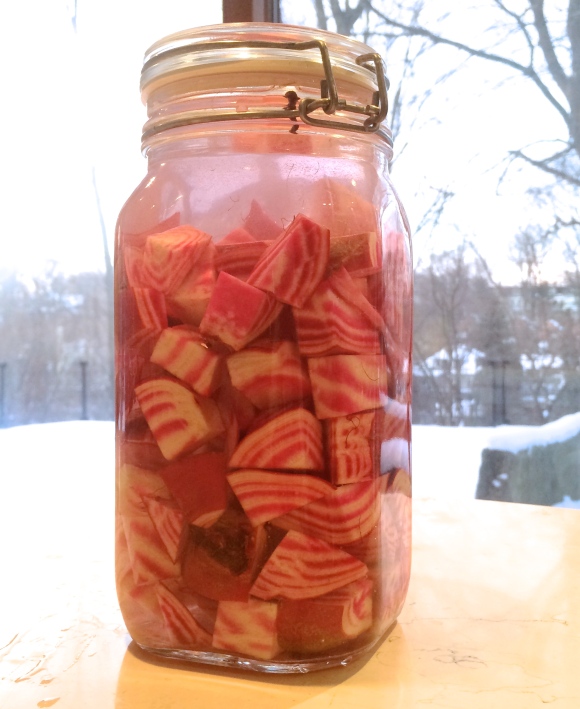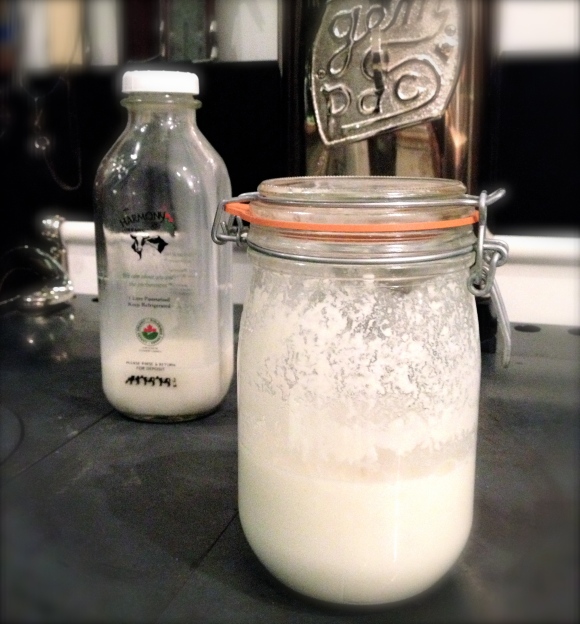 Seriously, let’s not make a big deal about this. A couple organic beets, some water, some salt and an air-lock jar. It’s like 5 minutes and then you forget about it for 3 weeks.
Seriously, let’s not make a big deal about this. A couple organic beets, some water, some salt and an air-lock jar. It’s like 5 minutes and then you forget about it for 3 weeks.
Beet Kvass is a 10th century Ukranian probiotic sports drink, essentially, in that it’s full of electrolytes and is super hydrating. It also claims to be an anti-inflammatory blood tonic, to cleanse the liver, lower blood pressure, to oxygenate the blood and spare oxygen when exercising. The Ukranians call it a “Cure All”, and there’s a rumor that the only people who didn’t develop blood poisoning after the radioactive Chernobyll explosion are those that religiously consumed beet kvass. As such, beet kvass and juice are frequently recommended for cancer patients undergoing radiation therapy.

There are complicated ways to make it, and then there is THE EASIEST, most traditional method which is obviously my preference.
BEET KVASS DIRECTIONS
- Boil your kettle or whatever.
- Wash 2 BIG BEETS or 3 medium beets to get any major mud off of them. Don’t go nuts scrubbing because what we are looking for here is the Lactobacillus bacteria that is on the surface of the beets. Some recipes call for peeling the beets and then adding a whey starter culture. But in this recipe, we are acknowledging that the beet skin already contains the exact starter culture we want (isn’t nature cool?) and so we are going to work with the beets and not against them. Again it’s important to use raw, organic beets here because conventionally farmed root vegetables absorb all the toxic fertilizers and neuro-toxin pesticides that are needed to grow them – furthermore, conventional root vegetables are grown in mineral-starved and mostly dead soil so there’s really no point in eating them anyway.
 Cut up the beets, LEAVING THE SKIN AND SKETCHY HAIRS on, into rough cubes – smaller than an ice cube but much larger than dice. If you make the beet cubes too small, they will release too much juice and sugar and you will get a different type of bacteria involved that works too quickly, creating more alcohol than lactic acid, and the whole thing will be wrecked. Bigger cubes mean the work will be slow and encourage the right kind of bacteria.
Cut up the beets, LEAVING THE SKIN AND SKETCHY HAIRS on, into rough cubes – smaller than an ice cube but much larger than dice. If you make the beet cubes too small, they will release too much juice and sugar and you will get a different type of bacteria involved that works too quickly, creating more alcohol than lactic acid, and the whole thing will be wrecked. Bigger cubes mean the work will be slow and encourage the right kind of bacteria.- Add 1 heaping TBS of good SEA SALT (or Himalayan salt) into the bottom of a large (say a quart) jar that has an air-lock, or those clamps that compress a rubber seal. The jar is important because a lot of carbon dioxide is going to be created and it needs to escape; at the same time you don’t want to let any oxygen in. (Oxygen will encourage the wrong type of bacteria, which will then “spoil” your kvass).
 Pour about half a cup to a cup of boiling water from your kettle into your salted jar, and swirl it around until it dissolves. The only reason you boiled the water is to help the salt dissolve.
Pour about half a cup to a cup of boiling water from your kettle into your salted jar, and swirl it around until it dissolves. The only reason you boiled the water is to help the salt dissolve.- Fill up half of the jar with cold FILTERED WATER. You don’t want the water to be hot anymore or else it will “cook” the beets and their bacteria and enzymes. We need a lot of live action for this process.
- Shove in all the cut up beets you have just prepared. Hopefully they will all fit. If you need to add more cold water to cover the beets, do it. Try to leave an inch of airspace at the top of the jar. I’m lousy at leaving space, and usually pay for it a few weeks in when my kvass seeps out of the jar all over my marble countertop. Major fail.

- Seal the jar up, leave it out of direct sunlight at room temperature or slightly warmer and forget about it for 3 weeks. Lactobacillus prefers temperatures between 70-75 degrees F, and likes just this amount of salt, no less and not much more. You could add another 1/2 TBS of salt if you don’t mind the salty flavor, but that’s the limit for a quart jar and 2-3 beets.
OTHER FLAVORING OPTIONS
Maybe add a clove, a cardamom pod, a star anise, a bit of orange peel, a knob of ginger or anything you think will go nicely with the earthy flavor of fermented beet juice. The lactic acid will also work its magic on these ingredients, unlocking beneficial polyphenols.
IN THREE WEEKS TIME
During this time the Lactobacillus have been converting the carbohydrates in the beets into lactic acid, carbon dioxide and small amounts of acetic acid and ethyl alcohol. The carbon dioxide displaces any oxygen in the jar, creating an anaerobic environment suitable for subsequent species of Lactobacillus to propagate.
After three weeks, strain out the pink liquid and put it in a serving bottle, preferably with a flip-top airlock style lid, and keep in the fridge. Drink at your leisure – but start slow. Just half a cup a day is all you really need to get the benefits. You might not dig it at first, but you’ll get used to it. Like all the other weird stuff, you’ll end up craving this earthy, salty elixir too.
BONUS PROJECT
Leave about a cup of the liquid in the bottom of the beets, fill again with water and another TBS of salt, and ferment the same beets again for another three weeks.
After that point, you can strain out a second batch of kvass and also eat the slightly tangy beets on their own or in a salad. These 6 week old beets will have much less sugar in them, a slightly tangy taste and will be teeming with beneficial bacteria.
While beets are a pretty starchy, high carbohydrate vegetable for anyone on an LCHF (Low Carbohydrate High Fat) diet or similar – fermented beets are much lower in carbohydrates so totally acceptable. (Whereas if you just “pickle” beets the conventional way by boiling and dumping them into sugary vinegar, they will actually have a much higher level of carbohydrates and sugars. Don’t do that, silly!).
YOU’RE SO WILD, GIRL
When you ferment vegetables (or anything) without adding a starter culture, it’s called doing a “Wild Ferment”. You’re getting your starter culture from the very thing you are culturing. You can use wild yeasts when making bread and beer; you can use wild bacteria when fermenting vegetables and fruits – and cheeses, wines and meats etc. And that’s just way cooler and more natural. Let’s always do it wild. Less fuss, less muss: more WOW factor. Got it?
BODACIOUS BACTERIA
The bacteria in our body outnumber our own cells by a factor of ten, which has to make your jaw drop.
What that essentially means is that over the last couple billion years, Earth bacteria has been co-evolving with us – you might even say “designing us” – in ways to make itself more mobile, virulent and imaginative. Consider that bacteria used to be stuck to a rock underwater; now it can walk around, drive, fly airplanes and be exposed to all manner of exciting cuisines and experiences.
It’s not like we are just the hapless host; we have benefitted immensely from bacteria. Bacteria protects our skin membranes, gives us immunity to diseases, helps digest our food and even creates essential nutrients for us out of food that would otherwise be useless to us. Although there are hundreds of bacteria that are on our side, there are also bacteria that totally suck for us. By encouraging and cultivating the bacteria on our team, they will keep the bad bacteria at bay. It is totally heavy-handed for a human to go after bacteria in general, by means of anti-bacterial wipes and sprays. It’s not our job to try to target bad bacteria – we are too big and clumsy to figure it out. Our job is to promote the health and propagation of our good bacteria so that it can take care of the bad bacteria on our behalf. This is symbiosis, baby! Our good bacteria has been engaged in this dance for billions of years, so there no point presuming we can do it better just because Louis Pasteur figured out how to boil stuff.
Lactobacillus bacteria in particular inhibits the growth of diarrhea-related bacteria such as Shigella, Salmonella and E. Coli. In addition, Lactobacillus competes with pathogens for receptor sites at the mucosal cell surfaces (nose, mouth, underpants region and entire digestive tract), making it more difficult for us to get sick. What this means is that our body is meant to be teeming with Lactobacilli, and has evolved to thrive in its presence. However our modern, sanitized environments and dead, overly fibrous or rancid foods create conditions that deplete Lactobacillus along with other beneficial bacteria. So stop doing that.
Making and drinking beet kvass is too easy not to do. I know you have a couple beets down there in your fridge drawer that you have been too lazy to cook. So just spare five minutes of your time and get on with it. This is a great winter project, and much needed in this season of flu and cold.
FURTHER READING
Article on beet juice lowering blood pressure and sparing oxygen while exercising.
More detailed information about the different Lactobacillus bacterias and their products and by-products, including a table showing all the major lactic acid bacteria involved in fermented fruits and vegetables.
Dr. Mercola’s site claims one serving of fermented vegetables has more probiotics than an entire bottle of commercial probiotic supplements. In other words, don’t bother wasting your money on proprietarily limited commercial strains when making fermented vegetables is dead easy and way more useful.





 It’s great when it all works like this, because I like to be able to drink my kefir at night, and do all the work at the same time. However sometimes it’s just not ready in time, and I have to wait until morning. Sometimes I wait until morning and then it has gone too far – characterized by separating into curds and whey. (If this happens, you can then strain the kefir through a cheesecloth and
It’s great when it all works like this, because I like to be able to drink my kefir at night, and do all the work at the same time. However sometimes it’s just not ready in time, and I have to wait until morning. Sometimes I wait until morning and then it has gone too far – characterized by separating into curds and whey. (If this happens, you can then strain the kefir through a cheesecloth and